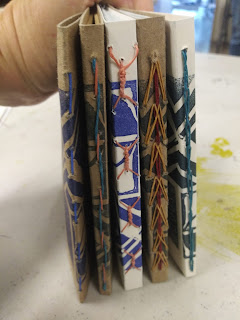 |
| www.karissalaurel.com |
While my dad is the other writer in our family, though mostly he is more into travel journaling than fiction, my mom and I have always bonded over our mutual affection for arts and crafts. Everything from drawing and painting, to crochet and knitting, and even culinary arts. Lately, my mom has really gotten into printing, which I think appeals to her STEM sensibilities. I think she like the creative side of it plenty, but I think she likes the mechanics of it even more.
Over the past year, I've joined her twice at the Sawtooth School of Visual Arts in Winston Salem, which is the approximate halfway point between her house and mine. The first time we met, we did a gel print class, which is a low-key printing method involving an inked gelatin block. Here's a pic of one of the prints I made in that class:
Step One: Designing an image and carving linoleum blocks:
 |
| Mary Beth asked us to create a block with a pattern on it |
Step Two: Create the print block.
 |
| The other classmates and I combined our blocks together to make one large print-block |
This is the actual form that will get inked. Then paper will get pressed over it. Placing these blocks took a tedious amount of fine-tuning and fussing, using a lot of specialized tools. You could also create trays filled with lines of words made from individual little letters, which is why this is called a letterpress. It made me so thankful we can just type on a computer and print on a laser-jet. Letterpresses make gorgeous results, but it would take hundreds of hours to print a whole book this way. It gave me great appreciation and understanding for why books were so rare and expensive, once upon a time.
Step 3 &4: Ink the rollers, register the paper, and start printing
We made multiple copies, first with blue ink and then blending in yellow ink to do a "rainbow" print, which I loved because the color shades were beautiful. Here are the results:
 |
| This is a simple "chain stitch" binding |
Realistically, I might use the skills I learned in this workshop to create hand-made journals to give to friends for Christmas. But, if I ever accidentally touch a circle of magic standing stones and get whisked 200 years into the past, I should be able to find gainful employment working in Jamie Fraser's print shop in New Bern, making seditious pamphlets to incite rebellion against the English Crown. Yes, that's an Outlander reference, in case you were wondering.







No comments:
Post a Comment